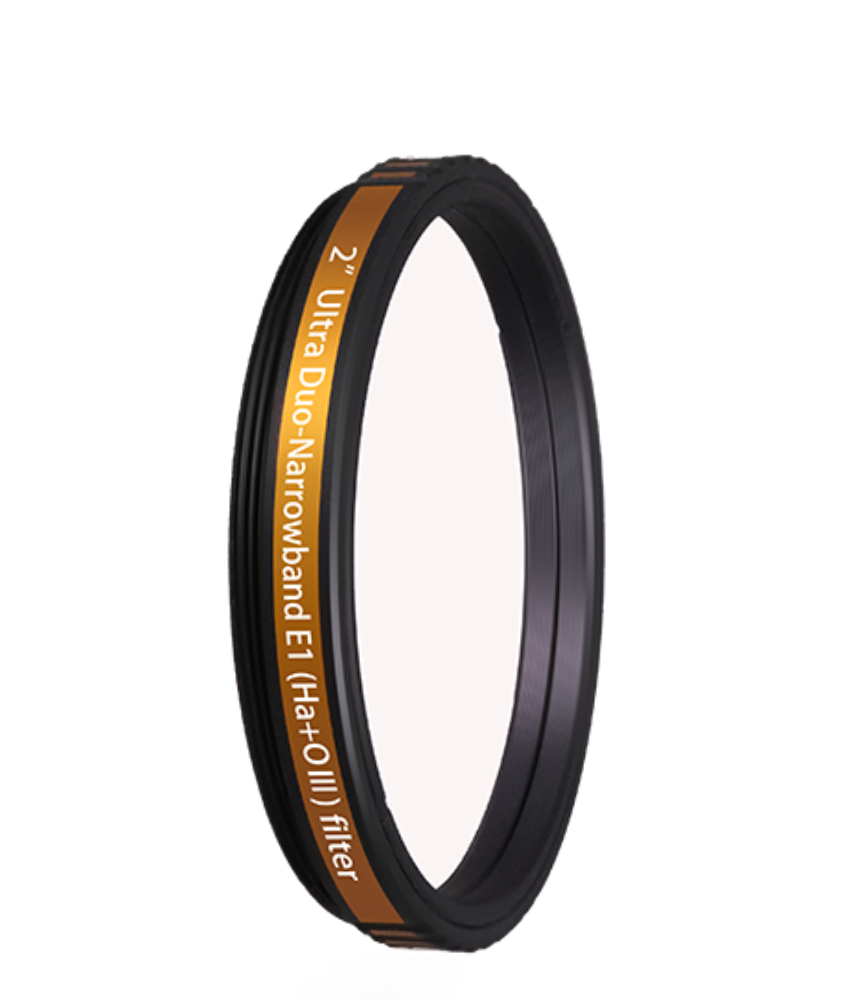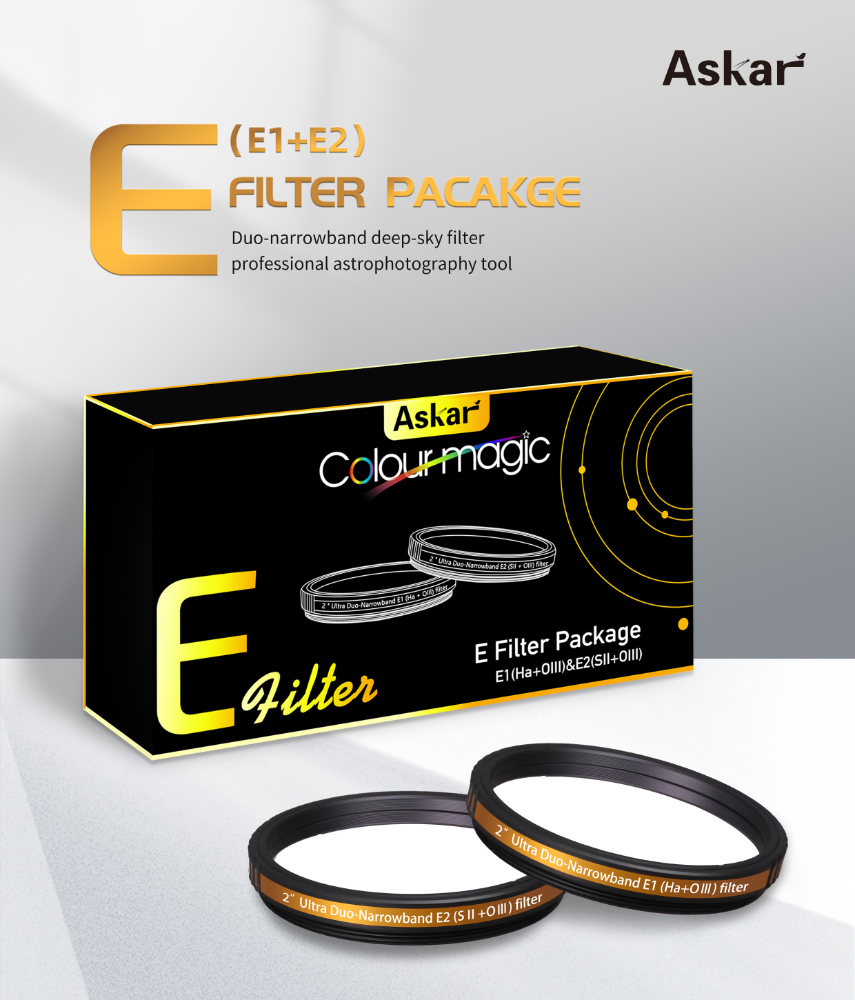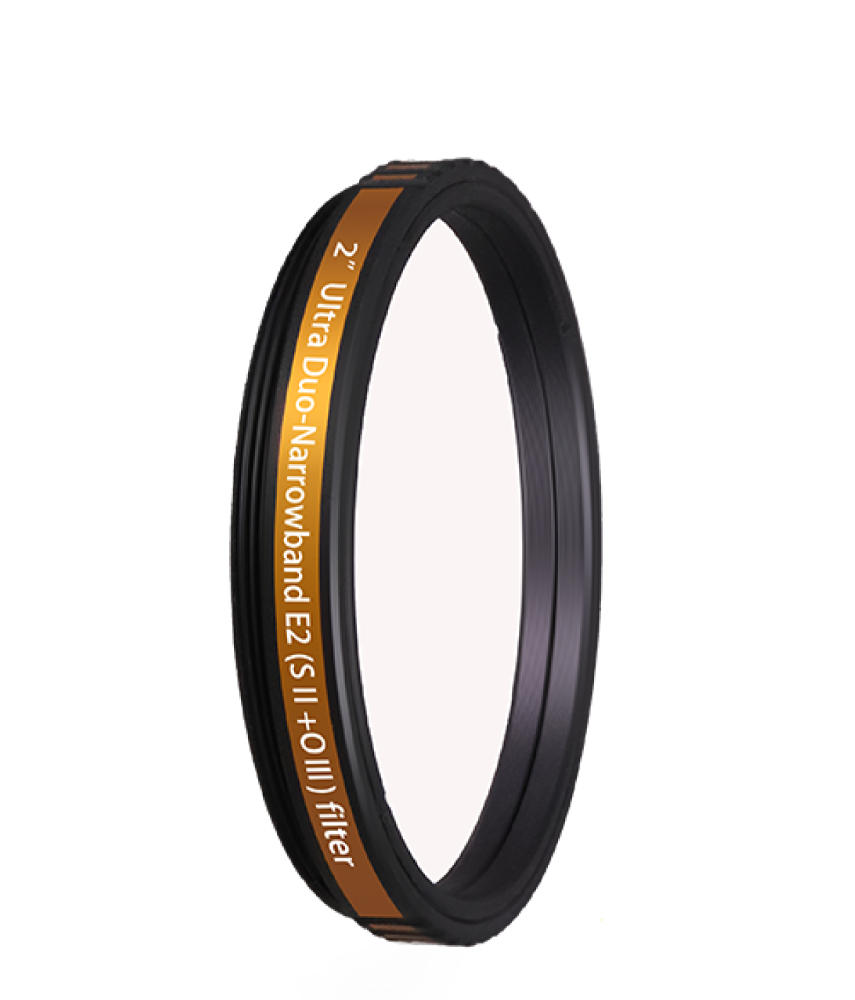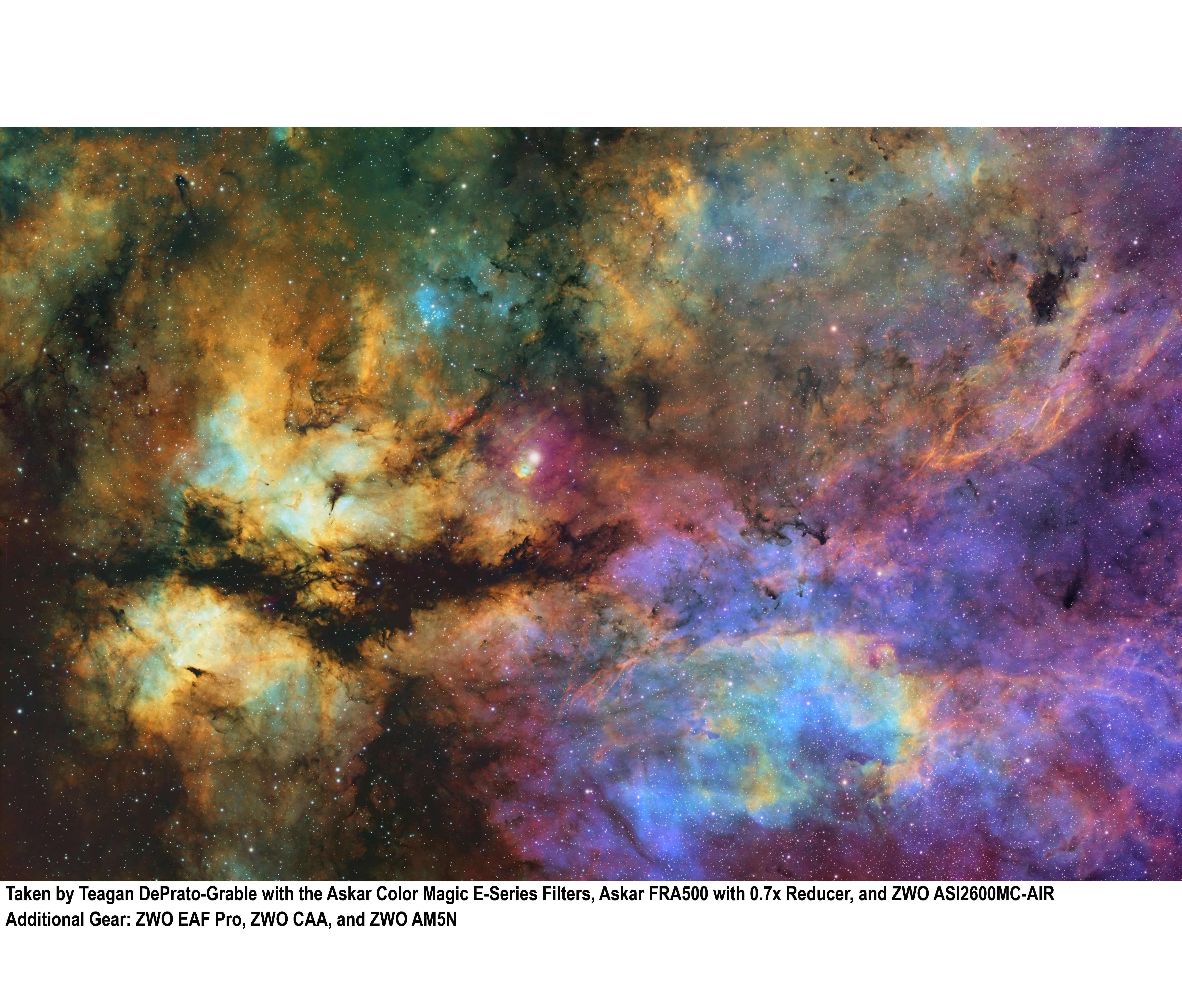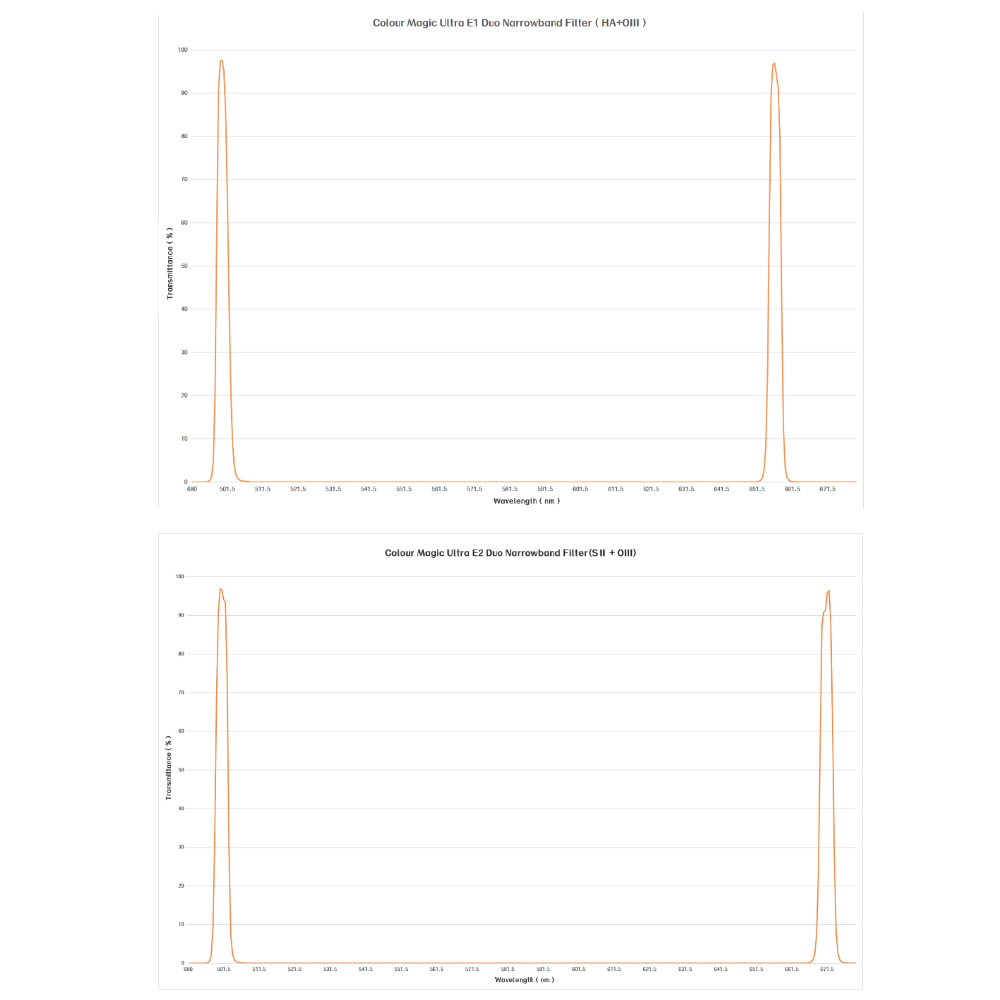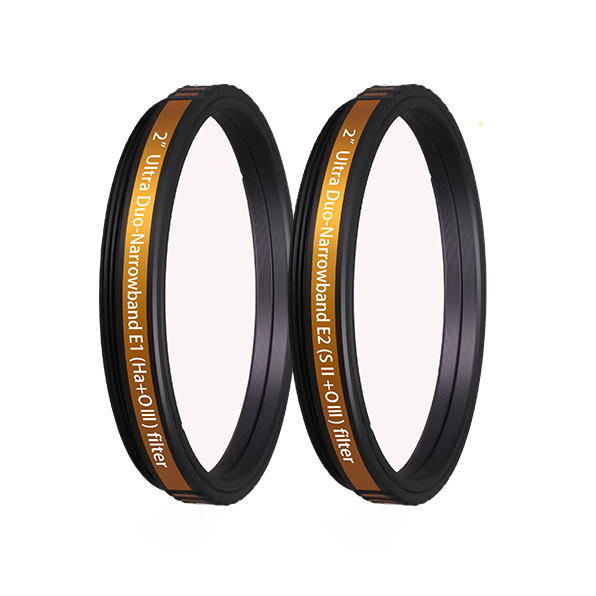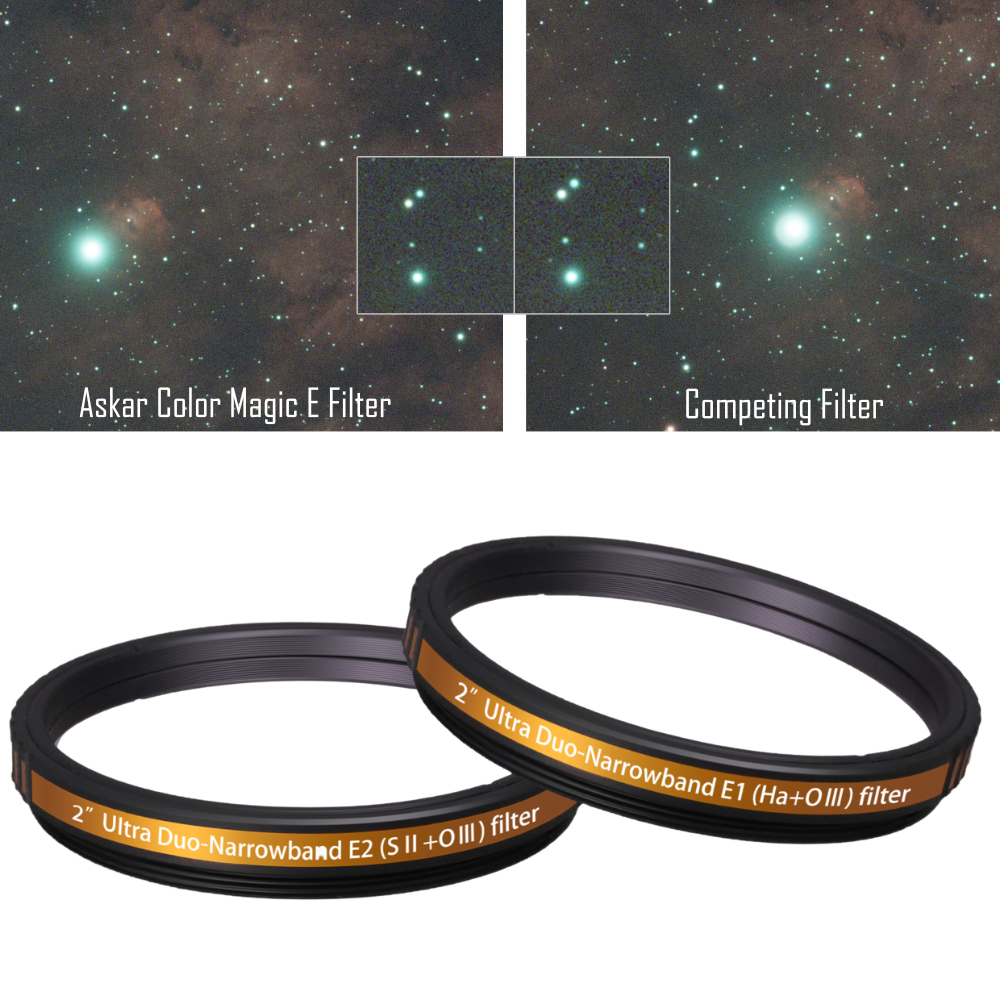Askar Color Magic Ultra E 2" Duo-band Filter Package
A High Performance Duo Narrowband Filter Set From Askar
Up until now, SHO narrowband imaging typically required three separate filters, a pricey monochrome camera, and at least three sets of data acquisition. With this Askar Color Magic Ultra E Filter Package, however, SHO narrowband imaging is easier and more affordable than ever before! With just two filters and your color camera, you can collect all three wavelengths—Hydrogen-Alpha (Ha), Sulfur-II (SII), and Oxygen-III (OIII)—with just two data sets, helping you save both time and money. Create stunning astrophotos with the popular Hubble Palette on the Cygnus Wall, the Veil Nebula, the Lagoon Nebula, and plenty more, with ease!
The two filters included within this package are the Askar Color Magic Ultra E1 (Ha and OIII) and E2 (SII and OIII) dual-narrowband filters. Both filters feature exceptionally narrow bandwidths and a high transmittance over 85% at their center wavelengths for striking detail. After imaging through both filters, combine the collected data within your favorite post-processing software to create colorful, vibrant astrophotos. The impressive light blocking power offered by these filters delivers stark detail and reduces the detrimental effects of light pollution. This means even from the city, you can enjoy beautiful, crisp resolution on a host of celestial bodies. Precision crafted, these Askar filters effectively control halos around bright stars for peak performance, while the 2” threaded design enables seamless integration within your imaging train. Professional-grade and designed specifically for deep-sky imaging, this Askar Color Magic Ultra E Filter Package has you set up for success!
SHO Imaging With Your One Shot Color Camera!
While both filters perform exceptionally well in their own right, the combination of data is truly where the “magic” of this Askar Color Magic Ultra E filter set becomes evident! Ha is supplied by the Ultra E1 filter, SII by the Ultra E2 filter, and OIII by both. Mapping the SII data to red, Ha to green, and OIII to blue, you’re well equipped in blending science and art—clearly distinguishing each wavelength in a colorful, creative way. What was once reserved for monochrome imagers, Askar opens the doors to new, innovative ways of capturing narrowband data. Now, there is no need to purchase an expensive monochrome camera and three distinct filters, nor will you have to spend an extensive amount of time imaging through a trio of filters. This unique method of recording SHO data from Askar is highly convenient, cost-effective, and time-efficient!
Take Your Deep Space Imaging to the Next Level
The Askar Colour Magic Ultra E 2” Duo-Narrowband Filter Package includes two high-performance astrophotography accessories specifically designed for narrowband imaging. With in-depth, precision engineering, this filter set delivers outstanding images of the cosmos! Read on as we dive deeper into the aspects of this Askar filter package.
Capturing Emission Nebulae
As their name suggests, emission nebulae are those that emit light, with Ha, OIII, and SII being some of the most common wavelengths radiated. Isolating these wavelengths with a high degree of precision, this Askar Ultra E1 filter is specially designed to selectively transmit only Ha and OIII with narrow bandwidths of 3.7nm ± 0.3nm and 4 ± 0.3nm, respectively, while the Ultra E2 filter isolates the SII and OIII wavelengths with bandwidths of 4nm ± 0.3nm and 3.7 ± 0.3nm, respectively. This selective filtering along the central wavelengths of 656.6nm & 500.7nm for the Ultra E1 filter and 672nm & 500.7nm for the Ultra E2 filter not only effectively inhibit man-made light pollution, but moon glow is also well-controlled, offering increased imaging opportunities! Even with a gibbous Moon present amongst urban city lighting, you can capture beautiful detail on star forming regions, planetary nebulae, as well as supernova remnants.
Extensive Compatability
With its 2” diameter, the Askar Color Magic E Filters effectively cover sensors up to full frame in size, making it a perfect choice for a wide variety of imaging set ups. This standard size is compatible with the majority of filter wheels, filter holders, telescopes, and optical accessories on the market today! Also, the integrated threads deliver a secure fit and quick installation. This threaded design ensures your filter stays put throughout your night of imaging and prevents accidental misalignment for the utmost image quality.
Exceptional Build Quality
Thanks to Askar, you can expect maximum light throughput with the rated surface finish of 60/40 on both the Ultra E1 and E2 filters. This precision craftsmanship is demonstrated through the high 85% transmittance rate for bright detail, a mark of optical excellence. Providing impressive contrast, the barrier property of ≥OD5 @ 200-1100nm means these filters block ≥99.999% of the unwanted light from 200 nm (within the UV range) to 1100 nm (near-IR), leaving behind only the desired wavelengths. The premium build quality doesn’t stop there! These filters feature a parallelism of 30 arcseconds, signifying precise alignment of the two surfaces of the glass for sharp, crisp images with incredible color accuracy. Halos around bright stars are well controlled, making this Askar Color Magic Ultra E Filter set a must have imaging accessory within your astrophotography toolkit.
Astronomy Hub: Your one-stop-shop for Astrophotography Knowledge!
Our Gear Experts have compiled a wealth of information to help expand your astrophotography knowledge! Below you’ll find links to articles, videos and "how-to" guides. Just one more reason that our Astronomy Hub is a one-stop-shop for all your astronomy and astrophotography needs!
| Tutorial: Combining Narrowband Data in Pixinsight |
| What is a Nebula and Which are the Best Ones? |
| Choosing the Best Deep Sky Camera |



